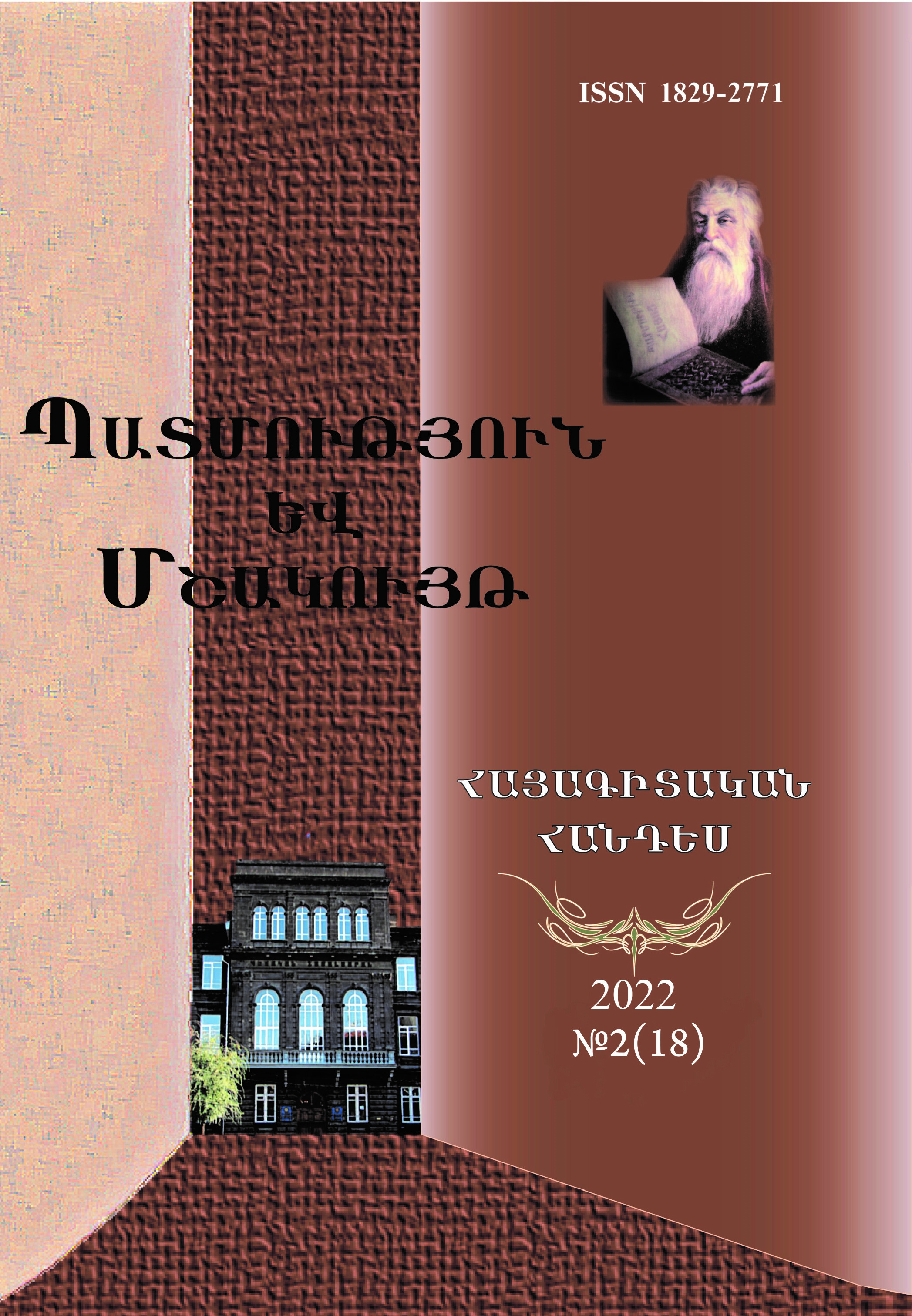On the Question of the Semantic-Functional Relationship between the Two Forms of the Subjunctive in Classical Armenian
DOI:
https://doi.org/10.46991/hc.2022.18.2.150Keywords:
the present subjunctive, the aorist subjunctive, Classical Armenian, a mood contrast, an aspect-mood contrast, an aspectual contrast, contextual-semantic analysis, syntactic functions, imperfective – perfectiveAbstract
It is argued that attempts to characterize the semantic relationship between the two forms of the Subjunctive (the present subjunctive and the aorist subjunctive) in Classical Armenian as either a mood contrast or an aspect-mood contrast are not backed up by the relevant synchronic as well as diachronic linguistic data of Old Armenian. The nearly identical syntactic functions of the two forms of the Subjunctive in Classical Armenian, along with their diachronically similar morphological structure (owing to the addition of one and the same suffix *-ից to either the present stem or the aorist stem), leaves no doubt that the both forms under consideration are subjunctive-mood forms. As to the difference in the frequency of use of the two forms of the Subjunctive in Classical Armenian, it should be accounted for by the general diachronic tendency for the present subjunctive to get restricted in use and displaced gradually by the aorist subjunctive. On the other hand, a detailed contextual-semantic analysis of uses of the present subjunctive and the aorist subjunctive in Classical Armenian, clearly testifies to the original aspectual (imperfective - perfective) contrast between them. However, it is also evident that the aspectual contrast had already ceased to be conceived of as a living grammatical phenomenon in the case of the Subjunctive in Classical Armenian and therefore did not manifest itself in a regular way: in aspectual terms identical actions/events were often expressed both by the present subjunctive and the aorist subjunctive. Moreover, they could even occur side by side within one and the same sentence.
References
Abeghyan M. (1974), Yerker, h. Z, Ye., hrat. HSSH GA, 848 ej. (In Armenian)
Abrahamyan A. (1976), Grabari dzeṛnark, Ye., hrat. “Luys”, 558 ej. (In Armenian)
Achaṛyan H. (1959), Liakatar kʻerakanutʻyun hayotsʻ lezvi, h․ IV, girkʻ A, Ye., hrat. HSSH GA, 594 ej. (In Armenian)
Avetisyan H. (1985), Grabari storadasakan yeghanakě yev nra ěmbṛnumě hay kʻerakanutʻyan patmutʻyan mej, “Banber Yerevani hamalsarani”, Ye’., N 1, 193-204 ej. (In Armenian)
Avetyan S. (2015), Anglereni zhamanakayin haraberaktsʻutʻyan kargi yev hayereni vochʻ iradrakan zhamanaki (yentʻa-)kargi zugadrakan kʻnnutʻyun, “Banber Yerevani hamalsarani”, Ye., N 1 (16), 38-40 ej. (In Armenian)
Avetyan S. (2022), Ardi arevelahayereni k(ə)- apaṛ’nii yev -u apaṛnii imastagortsaṛutʻayin pʻokh haraberutʻyan hartsʻi shurj, “Banber Yerevani hamalsarani. Banasirutʻyun’”, Ye., N 2, 22-35 ej. (In Armenian)
Awetikʻean G., (1815), Kʻerakanutʻiwn haykakan, Venetik, hrat. S. Ghazar, 580 ej. (In Armenian)
Bagratuni A., (1852), Hayerēn kʻerakanutʻiwn i pēts zargatsʻelotsʻ, Venetik, hrat. S. Ghazar, 744 ej. (In Armenian)
Dahl Ö. (1985), Tense and Aspect Systems, Oxford: Basil Blackwell, 213 p.
Dzhahukyan G. B. (1982), Sravnitel‘naya grammatika armjanskogo jazyka, Yerevan, Izdatel‘stvo AN SSR, 274 s. (In Russian)
Garagashean A. M. (1876), Gortsnakan kʻerakanutʻiwn hay lezui, K. Pōlis, hrat. Y. Gavafean, 248 ej. (In Armenian)
Godel R. (1975), An Introduction to the Study of Classical Armenian, Wiesbaden: Dr. Ludwig Reichert Verlag, 139 p.
Khachʻatryan L., Tʻosunyan G. (2004), Grabari dasagirkʻ, Ye., “Zangak-97”, 384 ej. (In Armenian)
Hambardzumyan V. (2018), Grabari dzeṛnark, Ye., “Editʻ Print’”, 436 ej. (In Armenian)
Hilpert M․ (2008), Germanic Future Constructions: A usage-based approach to language change, Amsterdam/Philadelphia: John Benjamins Publishing Company, 205 p.
Hovhannisyan L. (1975), Dasakan grabari bayakan zhamanakneri kiraṛutʻyuně, “Lezvi yev vochi harts‘er”, pr. III, Yer., hrat. HSSH GA, 252-319 ej. (In Armenian)
Jensen H. (1959), Altarmenische Grammatik, Heidelberg: Carl Winter. Univeritätsverlag, 224 S.
Karst J. (1901), Historische Grammatik des Kilikisch-Armenischen, Strassburg: Verlag Von Karl J. Trübner, 444 S.
Lyons J. (1977), Semantics, Vol. 2, Cambridge: Cambridge University Press, 897 p.
Meillet A. (1913), Altarmenisches Elementarbuch, Heidelberg: Carl Winters Univeritätsbuchhandlung, 212 S.
Meillet A. (1936), Esquisse d’une grammaire comparée de l’arménien classique, 2nde éd., Vienne: Imprimerie des PP. Mekhitharistes, 205 p.
Sampanis K․ (2017), The interplay between the future and the subjunctive mood in the diachrony of the Greek language // Lambert F., Allan R., Markopoulos Th. (eds.), The Greek Future and its History / Le futur grec et son histoire. Bibliothèque des cahiers de linguistique de Louvain, 139, Louvain-la-Neuve: Peeters, 237-251 pp.
Schmitt R. (2007), Grammatik des Klassisch-Arme¬nischen mit sprach¬ver¬gleichenden Erläuterungen, 2., durch¬ge¬sehene Auflage, Innsbruck: Institut für Sprachen und Literaturen der Universität Innsbruck, 253 S.
Wallace D. B. (1996), Greek Grammar Beyond the Basics, Grand Rapids, Michigan։ Zondervan Publishing House, 1996, 797 p.
Wallace D. B. (2000), The Basics of New Testament Syntax, Grand Rapids, Michigan: Zondervan, 2000, 336 p.
Downloads
Published
Issue
Section
License
Copyright (c) 2022 Սարգիս Ավետյան

This work is licensed under a Creative Commons Attribution-NonCommercial-ShareAlike 4.0 International License.

